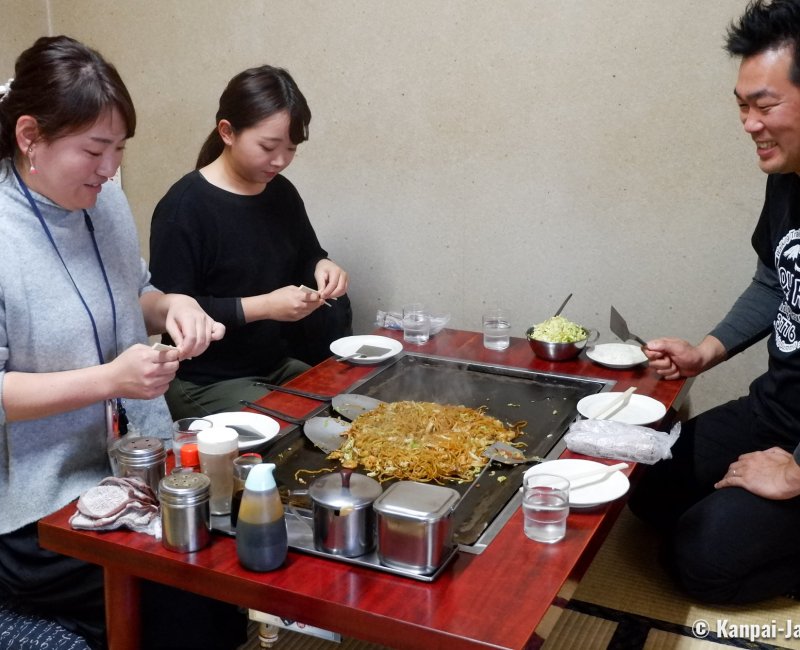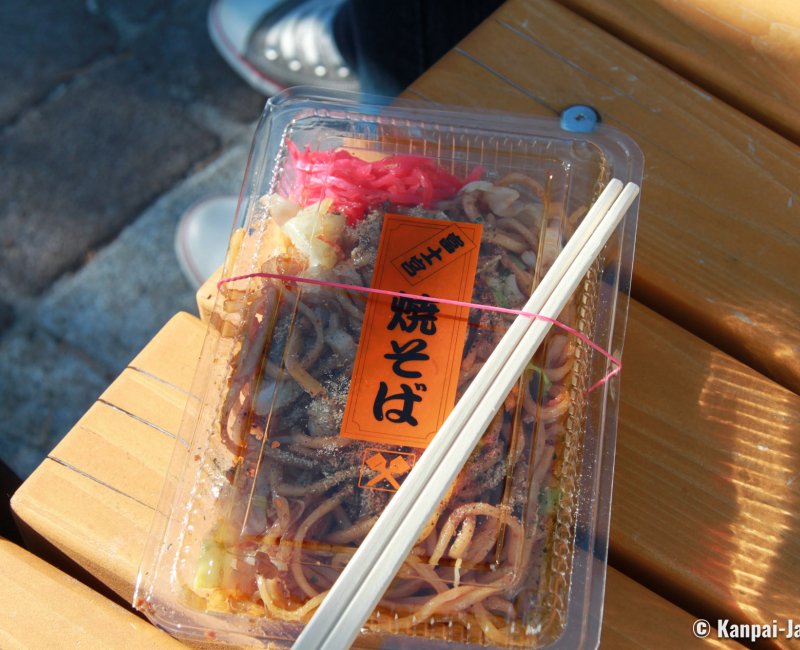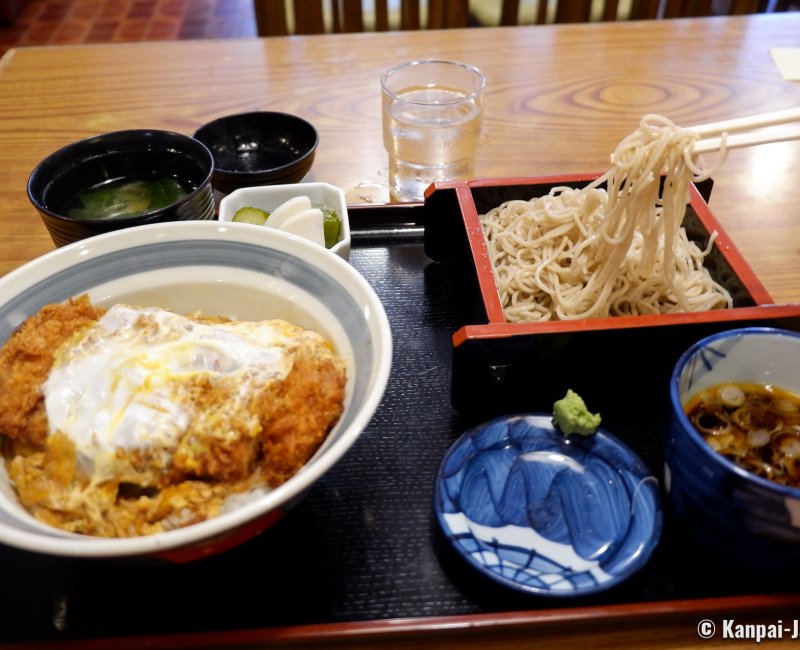Udon and Soba
Iconic Japanese Noodles
Soba and udon are the 2 noodles types most commonly consumed in Japan. These long noodles are made with buckwheat or wheat flour and can be enjoyed cold or hot, in a soup or stir-fried on a flat top grill and often sided with tempura fritters. Each place of the archipelago has its own recipe, so many regional specialties are to be discovered when traveling the country.
Aside from white rice, the Japanese love noodles and their many variations whose most popular are:
- Soba (蕎麦) are thin and long noodles, made with buckwheat flour which gives them their characteristic taste and gray-brown dark color;
- Udon (うどん) are long, thick and almost white noodles, made with wheat flour (soft wheat) that gives them their mellow and smooth taste.
Amateurs usually have their favorite type of noodles, but both are mostly eaten in the same way. Note that 100% buckwheat flour soba noodles are uncommon and most of their recipes include wheat flour that is used as a binding agent for the dough.
Contrary to the ramen 🍜, the famous wheat noodles from China served in a broth with toppings, udon and soba noodles are:
- 100% Japanese;
- Easily cooked at home; and,
- Can be enjoyed either hot or cold, dipped in a broth or stir-fried on a hot plate.

A national history of noodles
Buckwheat has been cultivated in Japan since the prehistoric Jomon period (c. 13,000 to 400 BCE). Its consumption increased during the Kamakura period (1185 – 1333) thanks to the introduction of windmill from China. Buckwheat was then shaped into small balls and dipped in a broth. The soba noodles began to look their current form of long and thin noodles similar to Italian spaghetti during the Edo feudal period (1603 – 1868) and became widespread in the Japanese people’s diet.
Soba noodles are staple food and a dish particularly popular to eat for New Year’s eve as they are a symbol of longevity. Also, there is a custom to offer noodles called 引越しそば hikkoshi soba to new neighbors when moving in a new home.
Information on the creation of udon in Japan is less specific. The thick noodles are supposedly originating from Kagawa prefecture on Shikoku Island. However, several stories coexist regarding their true creation periods, with conflicting dates. Like soba, udon noodles’ popularity increased during the Edo period and they started to be widely consumed.
Artisanal and industrial making
When traditionally made, the udon and soba noodles are hand-made, then sliced using a large rectangular knife called udon kiri or soba kiri. Tourists can easily take part to traditional noodles making workshops when traveling the archipelago, for an immersive sightseeing experience.
Since the Meiji Era (1868 – 1912) and the introduction of industrialized making processes, noodles have been produced on the large scale and they became a staple of any supermarket in the country or online grocery stores for international customers.
Noodles come in various packaging types: fresh, dried, pre-cooked or instant, and are very convenient to cook at home. You just have to boil them in water, prepare them following the recipe you like, and serve them as the main carbs of your dish.
A wide range of typical dishes
Japanese noodle-based recipes can accommodate both soba and udon. Therefore, one can choose a dish for its toppings first and then add the type of noodle one wants to eat.
Cold noodles
The ざるそば zaru soba and ざるうどん zaru udon are summertime dishes, with the noodles placed on a bamboo mat and to eat cold. The seasoning is a tsuyu ☔️ sauce prepared with dashi broth, soy sauce, mirin rice vinegar and sugar. It is served in a small cup on the side, into which the noodles are dipped.
A pickles or seasoning plate is also served on the side, usually including ginger, white or green onions, wasabi and sesame to spice up the sauce to taste. Cold noodles usually make a great pairing with vegetables, shrimp or meat tempura fritters.
Hot noodles
This category includes first and foremost the 焼きそば / うどん yaki soba / udon noodles that are stir-fried on a flat top grill, with a specific sauce and vegetables (cabbage, onions, carrots, soy bean sprouts), eggs, and sometimes slices of beef or pork meat.

Hot noodles are also served immersed in large bowls of tsuyu broth. The broth can be hot or cold, with various degrees of thickness and, consequently, flavors. The choices are available from:
- かけそば / うどん kake soba / udon, the most simple version, with a lighter taste.
- ぶっ かけ そば / うどん bukkake soba / udon, with a darker broth and stronger in taste.
- 釜揚げそば / うどん kamaage soba / udon, a dish using the noodles’ cooking water.
Each noodle soup has a specific or typical topping in Japan and is called according to it:
- 月見そば / うどん tsukimi soba / udon is characterized by a raw egg yolk placed on top of the dish whose shape is reminding of the round shape of the Moon (tsuki in Japanese).
- 釜玉そば / うどん kamatama soba / udon: a whole raw egg is quickly mixed to the broth and gives it an additional smoothness.
- たぬきそば / うどん tanuki soba / udon has tempura crumbs sprinkled into the broth.
- きつねそば / うどん kitsune soba / udon is topped with a slice of aburaage fried tofu.
- 天ぷらそば / うどん tempura soba / udon is mostly sided with shrimps or seasonal veggies’ tempura fritters.
- 山かけそば / うどん yamakake soba / udon contains yam puree adding its characteristic mucilaginous texture.
- 山菜そば / うどん sansai soba / udon is sided with vegetables and edible wild plants growing in the Japanese mountains.
- なめこそば / うどん nameko soba / udon includes mushroom whose name is nameko in Japanese (pholiota).
- カレーそば / うどん kare soba / udon, the noodles are immersed in a thick, hearty and piping hot Japanese curry broth.
- 鴨そば / うどん kamo soba / udon is topped with thin slices of duck breast, which is a quite expensive topping.
Regional names
Noodles can also be named after their areas of production. The most popular regional noodles are for example:
- 讃岐 うどん Sanuki udon from Kagawa;
- 伊勢 そば Ise soba from Ise-Shima peninsula;
- きし麺 Kishimen, the flat udon from Nagoya;
- 沖縄 そば Okinawa soba from the tropical archipelago; and,
- 団 子 汁 Dango 🍡-jiru, the thick soup with from Oita.

The various udon and soba restaurants in Japan
Fast-food chains
In the same way as curry or donburi rice balls’ shops, Japanese fast food restaurants only serving noodles are easy to find (in city centers and near residential neighborhoods). One can mention for example Marugame Seimen and Hanamaru, which are franchise-type udon restaurants.
Price wise, these shops are very affordable, between ¥300 (~US$1.91) to less than ¥1,000 (~US$6.37) for a noodle bowl and a hearty topping. Order and payment are made at the entrance at a vending machine that delivers a ticket to show to the kitchen counter. These restaurants are cafeteria-style and customers take they tray to the table. Drinks are freely available, with pitchers available for refill.
Some train 🚅 stations even have small shops on their platforms for busy travelers who can quickly slurp a bowl of noodles standing at the counter before catching their next train.
Specialized noodles restaurants
In large cities or smaller towns, many individually owned restaurants offer good soba and udon dishes, usually served in a set menu along with another bowl for a soup or a rice-based dish for example. The shop setting is often pleasantly decorated in a classical Japanese style. Allow on average approximately ¥1,000 (~US$6.37) for a full course at lunchtime.
More upscale and specialized restaurants have delicious tempura as side dishes, as well as some of the most expensive and delicate toppings like duck meat. Prices start on average from ¥1,500 (~US$9.55).
In the most traditional soba restaurants, there is a custom to bring the guest (at the end of the meal) the water used to cook the noodles, called 蕎麦湯 sobayu, that is blended with the remaining broth. The resulting soup is said to be good for digestion as it contains a lot of nutrients and antioxidants.

How to choose a good restaurant?
By following these 3 tips, you’ll be able to easily find a good noodle restaurant when traveling in Japan:
- Like for ramen shops, trust the length of the waiting line in front of the restaurant at lunchtime. It can, however, also be discouraging if too many people are waiting.
- Use the Internet 📶 reviewing sites (such as Tabelog or Google Maps). Restaurants rated 3,8 stars out of 5 (with more than 50 reviews) are often good. Shops with more than 4,2 stars out of 5 (rated by more than 100 customers) are most of the times very good. Note however that such popularity may require an advance booking.
- Ask the staff at your accommodation for the area’s good places and specific styles of restaurant.
Additionally, we have personally tried several good places in Tokyo, such as:
- いぶきうどん 吉祥寺店 Ibuki Udon in Kichijoji, a small affordable eatery, renowned in the neighborhood and with many dish types.
- そば処 福田屋 Fukudaya in Shibuya, a pleasant restaurant with courses prices varying from ¥1,000(~US$6.37) to ¥1,500 (~US$9.55).
- 神田まつや Kanda Matsuya, near Akihabara in a beautiful setting, and their udon and soba noodles are delicious;
- 千尋 Chihiro in Yanaka Ginza is specialized in soba dishes.
For Japanese people, the soba and udon noodles are a staple food as much as white rice. It is a dish they can eat on a daily basis and can adapt according to the season or the weather. The pasta / noodles market in Japan is by the way very varied and not exclusive to Japanese products. It is easy to find any kinds of noodles from the classical Italian spaghetti to the surprising translucent konjac noodles called shirataki.

